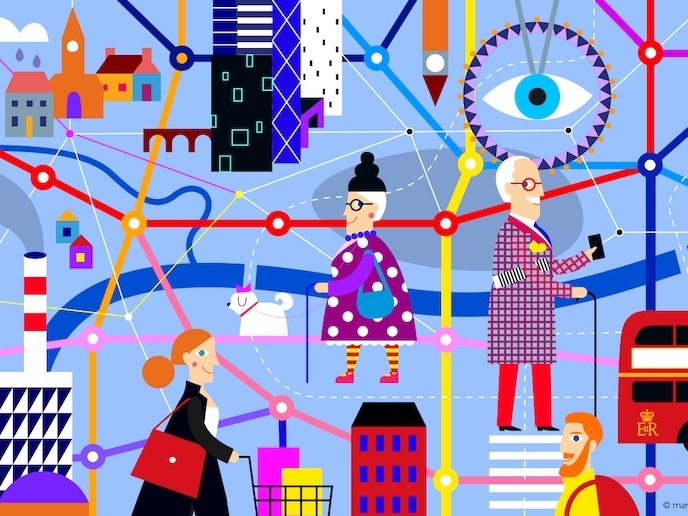Real life meets sci-fi: the embodiment station
VERE(opens in new window) (Virtual Embodiment and Robotic Re-Embodiment) was initiated in 2010 to build upon the rubber hand illusion and, more specifically, what it taught scientists 15 years ago regarding how the brain represents the body, and the plasticity of this representation. In this experiment, psychologists at the University of Pennsylvania had discovered that they could convince people that a rubber hand was their own by putting it on a table in front of them while stroking it in the same way as their real hand. The VERE project took this finding to the next level by trying to apply it to the whole body. Using novel sensory channels and incorporating both virtual reality and robotics, the team found that it is possible to provide people with an illusion of ownership over a body in virtual reality or an actual robotic body that behaves in correspondence and synchrony with their own movements. ‘In immersive virtual reality, a virtual body can substitute your real body. You see the virtual body when you look towards yourself, and in a virtual mirror, it is life-sized and it moves with your movements. It is possible to organise it so that when you see something touch your virtual body, you also feel it on your real body,’ explains Prof. Mel Slater, ICREA Research Professor at the University of Barcelona and coordinator of VERE. This is precisely the level of immersion that Prof. Slater and his team managed to reach with their ‘Embodiment Station’ directly inspired by the one featured in Surrogates. The station reads electrical brain signals and other physiological signals from participants, but it also transmits the visual, auditory and tactile inputs from the surrogate body while providing the real body with corresponding muscle stimulation. The Embodiment Station features a seat integrating different modules that provide specific sensory feedback and decode the participant’s motor intentions at the brain level by decoding EEG brain signals. It has already been proved to work even over large distances: for a participant in Israel who was successfully embodied in a robot in France, and for spinal cord injury patients in Italy who were embodied in a robot in Japan. Advancing state-of-the-art on all fronts As seen in Avatar, the project team focused part of their work on patients with disabilities, and more specifically those suffering from spinal cord injury. Since these patients lack the multisensory integration process, which is fundamental for bodily representation due to a massive sensorimotor deprivation below the lesion level, this research proved extremely useful in revealing the brain mechanisms of embodiment. Project results notably showed that even though these patients tend to have a reduced ability to embody an external object, boosting residual sensory information may still trigger embodiment. The latter is just one in many embodiment scenarios studied by the project partners, most of which are expected to lead to concrete advances in domains as varied as the rehabilitation of offenders, robotic embodiment for disabled people and gender-based domestic violence. ‘There are several variations of applications that enhance empathy, but much of this is now commercial-in-confidence,’ Prof. Slater reveals. The most notable VERE contributions include findings on how multisensory signals may elicit optimal embodiment sensations for the remote control of virtual or robot surrogates, which have a profound impact on the future design of brain-computer interface systems. The team also showed that vestibular inputs can enhance bodily self-awareness, potentially providing a new lever for virtual reality and neuroprosthetics. The project results open the way to virtual reality manipulations of body representation as a potential analgesic therapy. The consortium generated an ‘Atlas’ of the neuro-feedback sensitive brain areas, established the importance of both agent-form and motion-kinematics in the implementation of virtual scenes, and demonstrated that BOLD-fMRI can be effectively utilised in driving a robot and avatar in real time. The team demonstrated that amputees can navigate an avatar even while using the amputated arm representation. They also showed that virtual embodiment in a body that was considered as ‘out-group’ could lead to a reduction in racial bias. The ethics of VR technologies Another very important contribution of the project resides in its article ‘Real Virtuality: A Code of Ethical Conduct.’ As novel VR technologies such as Microsoft’s Hololens and Facebook’s Oculus prepare to enter the market, the project team looked into some of the risks that may arise with the commercial and research use of VR. ‘We are introducing a whole new technology so we need to understand its implications,’ points out Dr Slater. The document provides a first set of ethical recommendations to be built upon and notes areas in which further ethical deliberation will be needed. With regards to the risks posed to individuals and society, it extensively covers questions surrounding privacy, red lines for VR and the neglect of real bodies and environments. The effects of long-term immersion are also extensively covered in the paper. The other two parts are dedicated to ethical research aspects and questions related to plasticity in the human mind. As the paper concludes, ‘what is historically new, and what creates not only novel psychological risks but also entirely new ethical and legal dimensions, is that one VR gets ever more deeply embedded into another VR: the conscious mind of human beings, which has evolved under very specific conditions and over millions of years, now gets causally coupled and informationally woven into technical systems for representing possible realities.’ Until this world of a whole new kind emerges, the consortium intends to keep building on VERE results. ‘We are currently looking into the funding aspects of creating a spin-off,’ says Dr Slater. ‘However there are some commercial aspects involved and we cannot talk about the products yet.’







